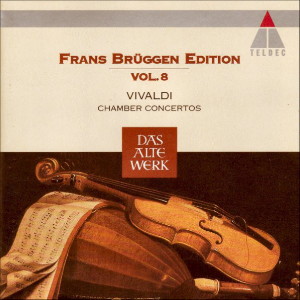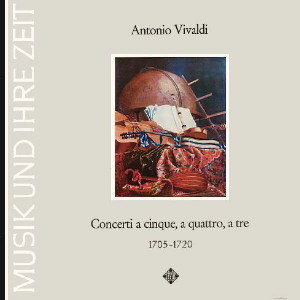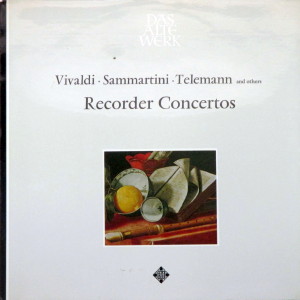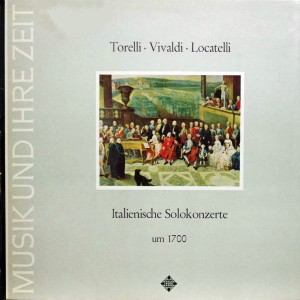 |
|
1 CD -
4509-97470-2 - (c) 1995
|

|
| 1 LP -
SAWT 9528-A - (p) 1968 |
 |
| 1 LP -
SAWT 9533-B - (p) 1968 |
 |
| 1 LP -
SAWT 9499-A - (p) 1966 |
|
| FRANS
BRÜGGEN EDITION - Volume 8 |
|
|
|
|
|
| Antonio Vivaldi
(1678-1741) |
|
|
|
|
|
| Concerto in D
major RV 94 - treble recorder,
oboe, violin, bassoon and basso
continuo |
10' 31" |
|
| 1.
Allegro |
4'
07" |
|
| 2.
Largo |
2'
31" |
|
| 3.
Allegro |
3'
53" |
|
| Concerto in D
major RV 92 - treble recorder,
violin and violoncello |
9' 34" |
|
| 4.
Allegro |
3'
57" |
|
| 5.
[Larghetto] |
2'
23" |
|
| 6.
Allegro |
3'
14" |
|
| Concerto
in G minor RV 105 - treble
recorder, oboe, violin, bassoon and
basso continuo |
8' 41" |
|
| 7.
Allegro |
3'
19" |
|
| 8. Largo
|
2'
03" |
|
| 9. Allegro |
3'
19" |
|
| Concerto
in C major RV 87 - treble
recorder, oboe, two violins and
basso continuo |
7' 25" |
|
| 10. Adagio ·
Allegro |
2'
55" |
|
| 11. Largo |
2'
28" |
|
12. Allegro assai
|
2'
02" |
|
| Concerto
in A minor RV 108 - treble recorder,
two violins and basso continuo |
7' 18" |
|
| 13. Allegro |
2'
52" |
|
| 14. Adagio |
1'
58" |
|
| 15. Allegro |
2'
28" |
|
| Concerto
in C minor RV 441 - treble recorder,
strings and basso continuo |
10' 44" |
|
| 16. Allegro non
molto |
4'
46" |
|
| 17. Largo
|
2'
07" |
|
| 18. Presto |
3'
49" |
|
| Concerto
in F major RV 442 - treble recorder,
strings and basso continuo (tutti
gli istrumenti sordini) |
8' 13" |
|
19. Allegro non
molto
|
3'
17" |
|
20. Largo e
cantabile
|
3'
14" |
|
| 21. Allegro |
1'
42" |
|
|
|
|
| Frans Brüggen, recorder |
Concentus Musicus
Wien (16-18) |
|
Jürg Schaeftlein,
oboe (1-15)
|
- Nikolaus
Harnoncourt & Frans Brüggen, principales |
|
| Otto Fleischmann,
bassoon (1-15) |
Concerto Amsterdam
(19-21) |
|
| Alice Harnoncourt,
violin (1-15) |
- Jaap Schröder,
principal
|
|
| Walter Pfeiffer,
violin (10-15) |
|
|
| Nikolaus Harnoncourt,
violin (1-15) |
|
|
| Gustav Leonhardt,
harpsichord (1-15, 19-21) |
|
|
| Anner Bylsma, violoncello
(19-21) |
|
|
|
|
|
|
Luogo
e data di registrazione |
|
-
Casino Zögernitz, Vienna (Austria)
- marzo 1969 [1-15]
- Casino Zögernitz, Vienna
(Austria) - febbraio 1968 [16-18]
- Bennebroek (Olanda) - gennaio
1966 [19-21] |
|
|
Registrazione:
live / studio |
|
studio |
|
|
Producer /
Engineer |
|
Wolf
Erichson [1-18]
|
|
|
Prima Edizione
LP |
|
-
Telefunken "Das Alte Werk" - SAWT
9528-A - (1 LP) - durata 42' 47" -
(p) 1968 - Analogico [1-15]
- Telefunken "Das Alte Werk" -
SAWT 9533-B - (1 LP) - durata 49'
51" - (p) 1969 - Analogico [16-18]
- Telefunken "Das Alte Werk" -
SAWT 9499-A - (1 LP) - durata 43'
30" - (p) 1966 - Analogico [19-21]
|
|
|
Edizione CD |
|
Teldec
- 4509-97470-2 - (1 CD) - durata
63' 29" - (c) 1995 - ADD |
|
|
Note |
|
- |
|
|
|
|
Even as late
as the early 18th century
the term “concerto” was
still ill-defined as a
concept but covered a range
of formal and stylistic
possibilities. In his Das
Neu-Eröffnete
Orchestre of 1713,
Johann Mattheson, for
example, proposed the
following definition:
“Broadly speaking, concerte
[of
English ‘consorts’] are
gatherings and collegia
musica; in the strict sense
of the term, however the
word is used not
infrequently of both vocal
and instrumental chamber
music [...]; in its
strictest sense, it applies
to violin pieces set in such
a way that each part is
shown to advantage at a
certain time and competes,
as it were, with the other
voices.”
The five concerti da
camera
for solo instruments and
continuo contained in the
present recording all date
from around 1705 to 1720
and, interestingly, occupy
the middle ground between
the sonata da camera
and the concerto for soloist
and orchestra. Typical of
the sonata da
camera
are the reduced resources,
the surprising departures
from traditional formal models
and the often songlike
cantilenas of the slow
movements, while the solo
concerto is the inspiration
behind the blocklike themes
of the fast movements and,
above all, the prominence
given to individual
instruments, a prominence
that invests these chamber
concertos with the sort of
virtuoso brilliance
generally lacking in the sonata
da camera.
(Listen, for example, to the
opening movement of RV 94,
in which the solo violin
emerges with ever greater
brilliance.) But not only is
the formal variety of these
concertos remarkable, so too
is their original
combination of instruments:
in the middle movement of
Concerto RV 94 the cantilena
of the treble recorder is
set, jewel-like,
within playfully
wide-ranging arpeggios on
the violin, with only the
bassoon providing harmonic
support, the string bass and
harpsichord having both
fallen silent.
Although the solo concertos
in C minor RV 441 and F
major RV 442 both date from
more or less the same period
as the concerti da
camera, they are
sharply contrasted as works.
The former exults in
the emotional force of its C
minor tonality, in its
weighty ritomellos and in
writing for the solo
instrument which,
violinistic in style, makes
this one of the most
technically demanding
recorder concertos
of the High Baroque, while
the F major Concerto uses
muted strings to create an
intimate, oddly reserved
effect that is further
emphasised by the minor
tonality of the middle
movement, which is cast in
the form of a siciliana.
Martin
Nitz
·····
A brief
history of the
recorder
8.
The recorder in the 18th
century
National
styles: England
During the
16th century it was largely
foreign recorder makers who
were active in England, with
the first indigenous makers
not making an appearance
until the second half of the
17th century.
In 1676 Thomas Garrett was
granted the Freedom of the
Turners’ Company, allowing
him to work as a
wood-turner. Among his
apprentices are believed to
have been both Bradbury and
Stanesby. Thomas Stanesby
(i) (c. 1668-1734)
was born in Derbyshire and
came to London during the
1680s, receiving the Freedom
of the Turners’ Company in
1691. Some eleven of his
instruments have survived,
including ten recorders: a
descant recorder (or “sixth
flute”) in d",
eight treble recorders (one
of which is heard in Vol.
1), a tenor recorder (or
“voice flute”) in d' and
a tenor instrument in c'.
Stanesby’s recorders reveal
certain similarities to
French instruments by the
Hotteterres, being solidly
made with a wide bore and
correspondingly pronounced
lower register These
features were taken over by
both Stanesby’s son and by
Peter Bressan.
Thomas Stanesby (ii)
(1692-1754) is believed to
have been active as a
wind-instrument maker for
more than ten years before
becoming a Freeman of the
Turners’ Company in 1728. He
was apprenticed to his
father in 1706 and on the
latter’s death in 1754
inherited all his tools
under the terms of his will.
In 1739
and again in 1740 he was
awarded the prestigious
title of Master of the
Turners’ Company. Unlike his
father, he was commercially
highly successful and on his
death in 1754 was described
by The Evening Post
of 2 March as having been "particularly
eminent for German Flutes".
He regularly produced luxury
instruments, advertising
them on his trade card as
“all sorts of Wind Musical
Instruments. In Ivory or
fine Wood; Plain, after a
very neat manner, or
curiously Adorn’d with Gold,
Silver, Ivory & c.”.
To judge by the number of
his surviving instruments,
Stanesby must have been
highly productive, almost 70
of his wind instruments
having survived the passage
of time. Among these are
some 15 recorders, including
a number of descant
instruments (a “sixth flute”
in d",
another in c”
and a “fourth flute” in b’
flat), eight treble
recorders and four tenor
recorders in c’ and
a low “fourth flute” in b’
flat. Of particular interest
is the “sixth flute” in the
Frans Brüggen
Collection (heard in the
Babell Concerto in Vol. 3), a
wellpreserved instrument
made of ivory, with carved
tendrils and cupids.
Peter Bressan was born
Pierre Jaillard
in Bourgen-Bresse in 1663.
Between 1678 and 1680 he was
apprenticed to the
wood-turner Jean
Boissier in Bourg and
between 1688 and 1730 lived
and worked in London under
the name of Bressan. He is
believed to have learned
instrument making in Paris -
probably in the Hotteterres’
workshop, since his
instruments are strikingly
similar to the Hotteterres’
French recorders. After
years of affluence, private
and financial problems
forced him to return to
France. He died in Tournai
in May 1731.
Unlike the younger Stanesby,
Bressan appears to have
concentrated on recorders:
his surviving instruments
include some 55 recorders,
but only three flutes. Of
particular importance are a
surviving “fourth flute”
heard in the recording of
Dieupart's G major Suite
(Vol. 6) and a number of
treble instruments and
“voice flutes” heard in
Telemann's A minor Fantasy
(Vol. 1) and Dieupart's A
major Suite respectively.
The majority of these
instruments are made of
precious materials such as
ivory.
Stanesby’s and Bressan’s
instruments are regarded as
the finest and most valuable
of all 18th-century
recorders and fully deserve
to be described as the
Amatis and Stradivariuses of
the recorder world.
Peter
Holtslag
Translation:
Stewart Spencer
|
|